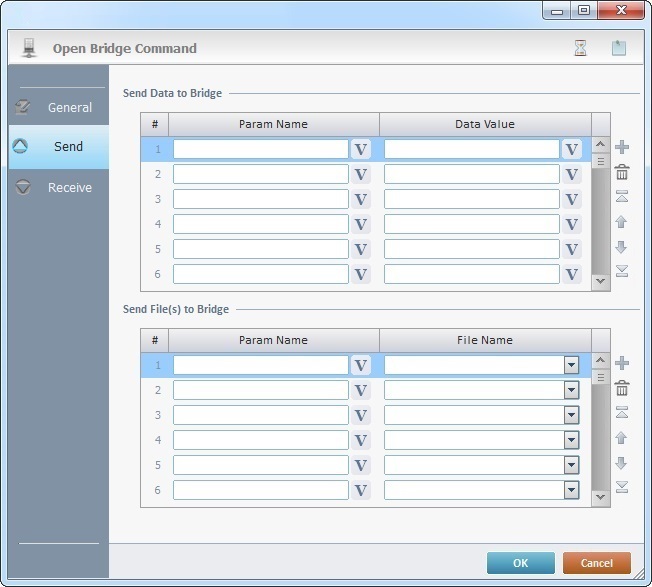Working with Open Bridge Command Process
Process Purpose
The "Open Bridge Command" process is used to create a customized bridge to enable sending and receiving data from a host.
You can send/receive up to 80 parameters/values in one single command.
When you add a process, you are required to define its settings. This occurs in the process's properties window which is displayed automatically after having added the "Open Bridge Command" process. In this case, the properties window includes three tabs - "General", "Send" and "Receive".
If any subsequent edition is required, double-click the process to open its properties window and enter the necessary modifications.
"General" tab

Fill in the following options:
Host |
|
Host Name |
Select a host profile from the drop-down OR click See To Create a Host Profile OR To Edit a Host Profile OR The <Default> Host Profile. |
Bridge |
|
Bridge Name |
Enter the bridge name OR click |
Method |
Enter the method OR click |
If Communication Error |
|
Go to |
Select a target location from the drop-down or
|
Detail of a ![]() window:
window:

"S:Menu" is a screen included in the same program as the process.
"R:Routine_1" is a routine included in the same program as the process.
Continue to the "Send" tab.
"Send" tab

Proceed as follows:
Send Data to Bridge |
|
Param Name column |
Enter the parameter name OR click |
Data Value column |
Enter the data value OR click |
Send File(s) to Bridge |
|
Param Name column |
Enter the parameter name OR click |
File Name column |
Select the data file name from the drop down. |
Use the editing icons to the right of the table to move the rows up and down and to delete or add more rows.
Click the "Receive" tab to continue.
"Receive" tab

Fill in the following options:
Receive Data from Bridge |
|
Param Name column |
Enter the parameter name name OR click |
Data Value column |
Click |
Receive File(s) to Bridge |
|
Param Name column |
Enter the parameter name name OR click |
File Name column |
Select the data file name from the drop down. |
Use the editing icons to the right of the table to move the rows up and down and to delete or add more rows.
Use the following recurring icons (located on the upper right corner of the properties window) to execute specific operations:
•Click ![]() to define a time out. See Time Out.
to define a time out. See Time Out.
•Click ![]() to attach any relevant notes to this process. Click it and enter your notes in the resulting text box. These notes will be displayed in the corresponding "Actions" tab or "Process" window (in the "Notes" field) and in the "Developer Report".
to attach any relevant notes to this process. Click it and enter your notes in the resulting text box. These notes will be displayed in the corresponding "Actions" tab or "Process" window (in the "Notes" field) and in the "Developer Report".
After filling in the required options, click ![]() to conclude or
to conclude or ![]() to abort the operation.
to abort the operation.
The added process is displayed in the corresponding "Actions" tab or "Process" window.
![]() You can use relative paths to refer the file(s) you want to use in your project. See Working with Aliases.
You can use relative paths to refer the file(s) you want to use in your project. See Working with Aliases.
![]() If you want to use a label as a target destination, you can use the "Auto-Label" mechanism. This alternative to the "Set Label" process allows you to create a label in the properties window of a process - specifically, in the fields used to define target destinations (ex: the "If Error..." type fields). See To Automatically Create a Label.
If you want to use a label as a target destination, you can use the "Auto-Label" mechanism. This alternative to the "Set Label" process allows you to create a label in the properties window of a process - specifically, in the fields used to define target destinations (ex: the "If Error..." type fields). See To Automatically Create a Label.
![]()
Use the right-click in MCL-Designer's input boxes to access some related options as well as the general "Cut", "Copy"; "Paste"; "Search" actions (active/inactive according to the current context).
Ex: If you right-click the "Variable" input box (included in a "Conversion's" properties window), you are provided with general editing/search actions and other more specific options such as "Variable Select" (see "Variable Select"); "Variable Insert" (see "Variable Insert"); "Insert Special Character" (see To Insert Special Characters into a Control's Text Input Field) and "Localization Select" (see Localization List).
If you right-click another input box, it may provide other possibilities.
